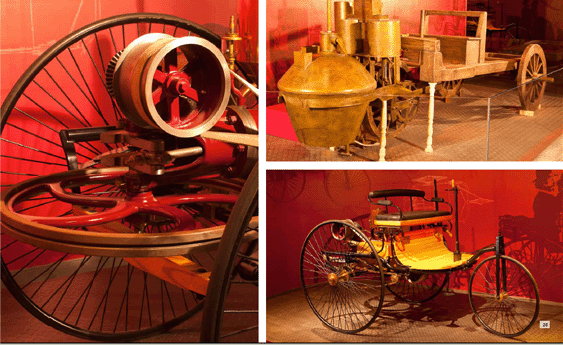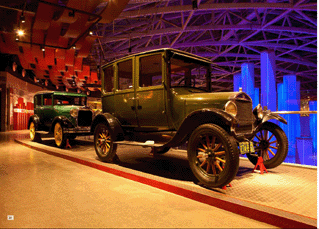Hall Of Innvation |
|
Birth and Development |
|
| The early agricultural period of the civilization lasted for thousands of years when man and animal powers were the main mode of transportation. The invention of steam engine and internal combustion engine eventually replaced horsepower in the 18th century during the industrial revolution in the West. In 1885, Karl Benz invented a gasoline-driven three-wheeler, the first of its kind in the world, and filed a patent application for it. The Mannheim Patent Office of Germany granted it on January 29, 1886. This date is usually regarded as the birth of modern car as the patented vehicle has all the basic features of modern automobile. Soon afterward, the installation of the first assembly line by Ford Company in the US in 1931 made cars affordable to broad masses of the people. The exhibition section of Birth and Development features four themes: “Wheels from China”, “Horseless Carriage”, “Machine that Changed the World” and “Close to the Public”. The long and slow process of the development of cars was unfolded through the horse-drawn carriages in China, the birth of steam engine, the earliest Mercedes Benz, and all the way to the Ford model T that rolled off from assembly lines. |  |
 |
Wheels from China | ||
| Regarded as one of the earliest countries that has invented wheels, China’s effort to make carts can be traced back to the Yellow Emperor (c. 5000 years ago). Apart from carrying things on shoulders and with hands, people also used rolling logs as a mode of transportation, which was deemed to be the prototype of wheels. | |||
 |
According to historical documents, people were inspired by observing the grass balls being whirled around by wind, which led to the invention of vehicles. With the technology further developed in making carriages, there appeared “kingdoms with a thousand carriages” or “ten thousand carriages” in the Spring and Autumn Periods (770-476 BC). Ancient China also witnessed the birth of south-pointing vehicles and distance-recording vehicles, demonstrating the advanced technology and prosperity at the time. |
| Horseless Carriage |  |
A glorious era of horse-drawn carriage predated the advent of car. Up to the 17th century, public coach, rental poach, post coach and fire coach, all important modes of public transportation, were seen shuttling along the streets and allays in Europe. In the 18th century, track carriages were popular in Europe and America, and were even used to transport coal in England. The appearance of the double-deck carriage in London in 1847 provided people with the comfort and leisure they had never enjoyed before. In 1886, when the “horseless carriage” invented by Daimler and Wilhelm Maybach from Germany traveled from Stuttgart to Constance Tate with a speed of 18 kilometers per hour, people felt “suffocated”. However, the first four-wheeler driven by a gasoline engine in the world was born in this manner. Since then, the coming of the car era is irresistible. |
 |
Machine That Changed the World |
The invention of the motorcar ushered in a land transportation revolution campaign in industrialized countries. The car industry provides an opportunity for man to explore new horizons in uncharted areas. It is also quietly transforming the life style of the public. The Beijing- Paris Motor Car Rally held in 1907 was the first cross-country car rally ever held in human history, and the first bold attempt to explore man’s dreams. Nonetheless, only mass produced in large numbers can motorcars become the machine that will really change the world. Inventions that will be forever remembered are numerous which will make our dream to travel faster, more comfortably and freely come true. |
| Close to the Public |  |
When the output of motorcars was limited, they were only luxuries. Henry Ford (1863-1947) in the US dreamt of making a car that was simple, durable and affordable to common people. In October 1908, the production of Model T made this dream a reality. The model was liked by all Americans, which resulted in supply falling short of demand. In 1913, Ford installed the first assembly line, accelerating the output of Model T in amazing numbers. Until May 1927 when the production stopped, the Fory Company churned out 15 million Model T cars during the span of 19 years. This model was the symbol of motorization and the assembly line was not only a revolution for the car manufacturing, but also a great event for the entire industry. As Model T made the US a real kingdom of cars, Henry Ford was hailed as a man who “has the world fitted with wheels” |
